Former Dean S. David Wu: Everything Must Relate to a Bigger Picture
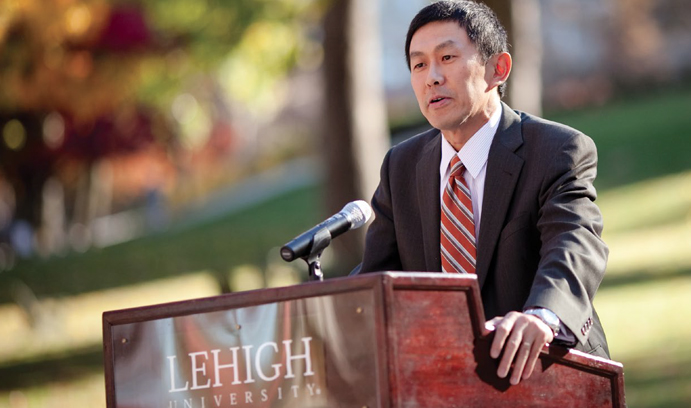
During his decade as dean of engineering, S. David Wu championed a vision of the engineer as “Renaissance person for the 21st century” and of engineering as a way of thinking that benefits leaders in many spheres of the economy.
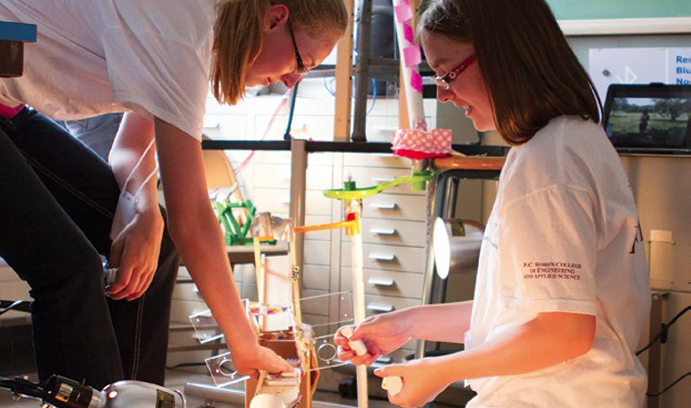
Under David's leadership, Lehigh's renowned CHOICES science and engineering camp for middle-school girls doubled its capacity and evolved with new programming and partnerships.
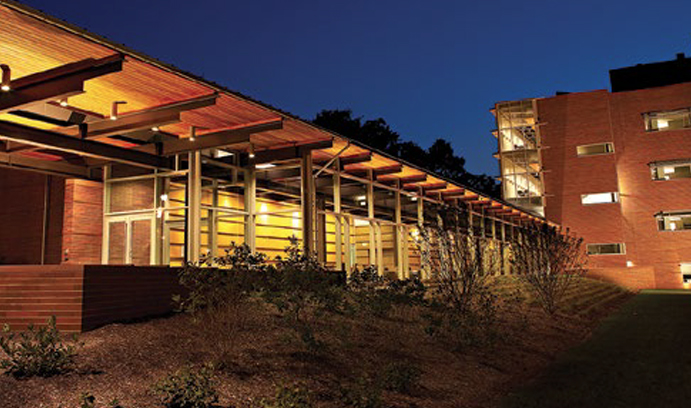
During his time as dean, David helped to recruit more than 40% of the current engineering faculty, and led efforts to create or renovate some 100,000 square feet of academic space. Pictured here is Lehigh’s Science, Technology, Environment, Policy, and Society (STEPS) building at its opening in 2010.
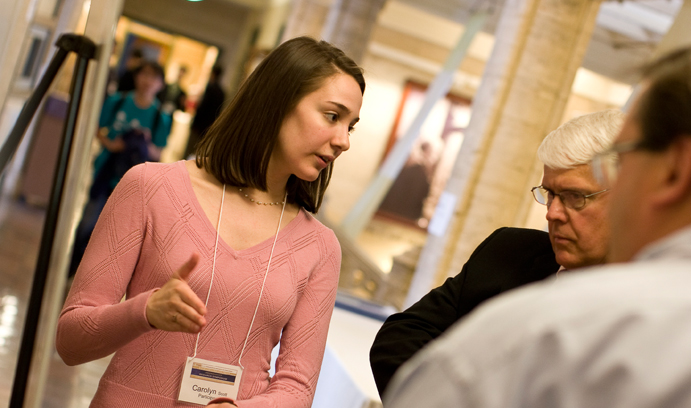
Carolyn Scott '10, now a Ph.D. candidate at the University of Minnesota, won first prize in the 2010 David and Lorraine Freed Undergraduate Research Symposium. In a 2013 "Faculty Forum" piece in the Brown and White, David challenged undergraduates to engage in research as a way to "develop instincts that allow you to make choices, methods that help you determine if you are on the right path, and skills that enable you to communicate so your ideas are adopted. These are the same skills you need to tackle almost any real-world problem."
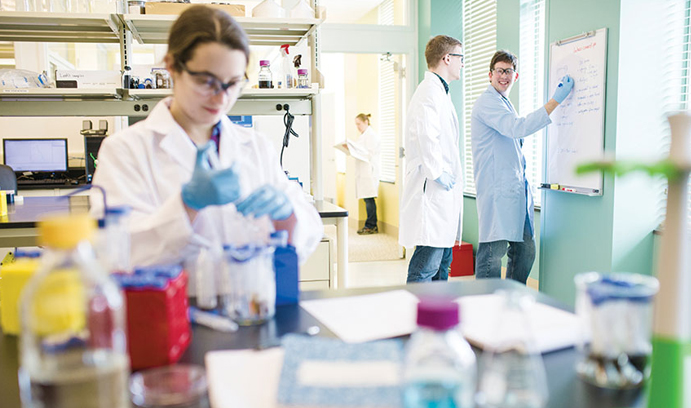
David helped forge multidisciplinary research initiatives in energy and infrastructure, in computing and data analytics, and, with help from an alliance with the Mayo Clinic, in health and healthcare delivery. Pictured here is the Health Research Hub, opened in 2014 with support from members of the Engineering Advisory Council, among other sources.
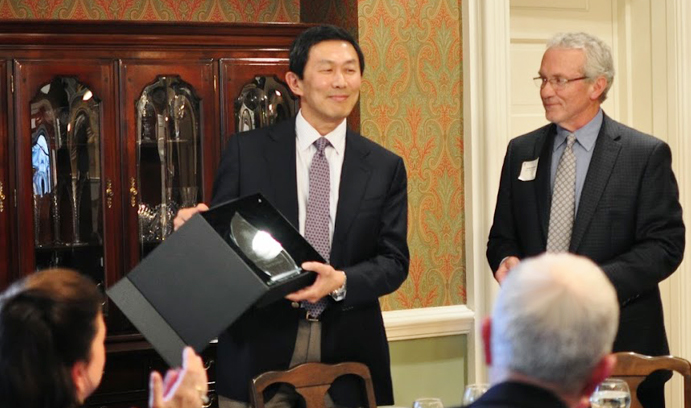
At the Engineering Advisory Council (EAC) dinner at the President’s House in Spring 2014, EAC chair Andy Greenawalt ‘76G ‘04P surprised David with the announcement of a newly-created endowed scholarship in David's name. "I find it a bit overwhelming that the Council members would take it upon themselves to put something like this together," said David, "and it reflects this group’s commitment to Lehigh Engineering."
During his decade as dean of engineering, S. David Wu championed a vision of the engineer as “Renaissance person for the 21st century” and of engineering as a way of thinking that benefits leaders in many spheres of the economy.
When he left Lehigh in July 2014 become provost of George Mason University, Wu left a powerful legacy founded upon a belief in collaboration. In his 27-year career at Lehigh, he devoted significant effort toward the development of cutting-edge multidisciplinary programs at the graduate and undergraduate levels, and played a key role in the creation of the university-wide Global Citizenship program. He was co-founder of the Center for Value Chain Research, a joint initiative of Lehigh’s business and engineering colleges.
Wu championed a team-based research model—“clustered” initiatives and resources that elevate the institution’s approach to solving grand societal challenges. His partnerships with key alumni and business-community constituents channeled energy and expertise into exciting opportunities for generations of faculty and students to come.
The following article examines Wu’s impact as dean through the eyes of a handful of young alumni who’ve flourished, in part, through their experience in some of the programs Wu helped to put into place.
These and countless others exemplify a principle Wu often shared with friends and colleagues among the Lehigh community: “Engineers educated at Lehigh,” Wu said, “are not pocket protector engineers; rather, they are well-balanced individuals who are trained to think rigorously and imaginatively and who use engineering as a platform to bigger and better things.”
IDEAS
Michelle Spicer ’12, M.S. ‘14 (TEST)
Michele Spicer brought her passions for music, languages and the environment to a freshman engineering course taught by IDEAS director Bill Best.
“He said I was an ideal candidate for the IDEAS program,” Spicer recalls. “He told me, ‘You might come back to us one day.’”
Two years later, after stretching the limits of her chemical engineering curriculum, “taking Spanish classes and environmental science any time there was a tiny free moment,” Spicer knocked on Best’s door.
As an IDEAS student, Spicer took courses in engineering, environmental sustainability and Spanish. For her senior thesis, she studied a small town in Scotland where wind energy had succeeded because the nearby turbine gave people a social rallying point. Social acceptance, she learned, is critical in introducing renewable energy sources.
“You can’t decide the best place to install wind energy based just on the science. Just because we have massive wind in a wind belt doesn’t mean that’s where we should put turbines. What I loved about IDEAS is that you take a holistic view. I looked at what works and doesn’t work societally, and at the technological barriers and political and economic impacts.”
After completing her degree, Spicer spent two months in Costa Rica as an Iacocca Intern. To incorporate sustainability principles into the curriculum for fourth graders in a low-income area, she used everyday objects to illustrate environmental concepts.
Spicer earned an M.S. in environmental science from Lehigh and is now a Ph.D. student in forest ecology at the University of Pittsburgh. “I’m so glad I did an integrated degree,” she says. “The same math and science concepts engineers use to explain industrial processes—heat transfer, mass transfer, fluid dynamics—help explain the natural world, too.”
David and Lorraine Freed Undergraduate Research Symposium
Carolyn Scott ’10
Carolyn Scott was excited when Sabrina Jedlicka, assistant professor of materials science and engineering, encouraged her to enter the David and Lorraine Freed Undergraduate Research Symposium in her senior year.
Scott’s poster won first prize in the competition. Her research involved taking an adult stem cell and making it a functional neural cell by designing peptides that would trigger development in the precursor cells. The goal was to determine which protein segments spurred development, and then to design peptides, which are smaller, more easily manipulated molecules, to mimic this action.
“We were looking for specific markers for the neural cell we were trying to develop, and we started to see expression of the proteins we would expect to see from those cells,” she says.
Scott, now a Ph.D. candidate at the University of Minnesota, says her Lehigh education gave her more than a research focus. “Prof. Jedlicka exposed me to working in a wet lab and showed me how to ask the right questions and design an experiment to answer them.”
The Freed symposium, which requires students to make presentations to judges, boosted Scott’s confidence in her ability to communicate.
“Working in a close lab group it can be easy to forget that there are people outside who don’t understand what you are doing,” she says. “I have to be able to think about my work on different levels and explain to people why they should care about it.”
The field of stem cell research, says Scott, is temporarily stalled. “When we declare that we’re successful and that we’ve produced, say, a liver cell, what we mean is we have cells that behave like liver cells in a very immature liver. We have not gotten to developing full adult cells.”
“It’s a field-wide question we’re asking: What are we missing?” she says. “We don’t know yet. That will be my next few years, I guess.”
M.Eng. in Energy Systems Engineering
Robert Smith ’14
Robert Smith says ESE’s project focus and breadth—covering energy economics, the environment and technology—set him on the correct career trajectory.
“I developed my program and technical electives to meet the need I saw in the electric utility industry,” he says. “I knew smart grid technology was being deployed more than ever before, and the data that it generated was substantial.”
The ESE degree helped Smith land a job as lead energy research analyst with Colorado Springs Utilities, where he leverages data to gain insight into demand-response, renewable energy and other initiatives. He beat out 200 candidates in a process that required him to develop a long-term projection incorporating socioeconomic and demographic data.
“They gave me three days,” he says. “I spent 40 hours on it, the weekend before [ESE] finals.”
At CSU, Smith continues to develop detailed predictive models that “give us a strategic vision of what we should expect to see happening on our electric system over the next 20 years.
“We’re in a period of transition in our industry away from a top-down framework,” he says. Power is generated not just by large coal plants but by homeowners’ solar arrays. The distribution of electricity is being increasingly monitored by sensors throughout the grid.
“The days of big coal and gas plants are largely behind us. We’re moving to a more decentralized generation system.” Smart grid technologies, and attendant data flows, will continue to expand.
Smith works with CSU’s Eco-Saver Program, which paid 600 customers to install a remote-controlled smart thermostat in their homes.
“On a really hot day we can save you money if we ratchet your thermostat up a few degrees,” he says. While customers can choose to override the utility’s request, such demand-response programs can help utilities shave peak demand, saving energy and money.
“If we can put off adding additional generation capacity for a few years,” says Smith, “then ratepayers don’t bear that cost.”
M.Eng. in Structural Engineering
Vincent Antes ’08 ’09G
Lehigh’s M.Eng. in structural engineering gave Vincent Antes practical experience and industry connections. Much of the program’s credibility, says Antes, comes from its director, Jennifer H. Gross, who spent 12 years in industry working on projects such as the Gaylord National Harbor convention facility in Maryland and a 10-story tower addition to Philadelphia’s Children’s Hospital.
“In design classes, she discussed real examples, and shared her thinking,” Antes says. “She taught that you can’t just think about how a structure is going to work, you have to think about how it interacts with all the architectural and mechanical components intertwined with it.”
Antes is now a senior structural engineer with Ammann & Whitney, an international practice based in New York. He has worked on airport terminals, parking garages and the Arecibo Observatory radio telescope in Puerto Rico.
“I like to look at the overall picture first, then dissect it into smaller parts,” he says. “I rarely deal with a problem that is purely structural. Everything has to relate to a bigger picture.
“I can make a structure strong enough, that’s easy: Just pick the biggest beams and columns and it will work. But I also have to think about how much it will cost to build a design, how easy it is to construct it, and how the mechanical, electrical and other systems fit in.”
Antes credits his ability to interact with corporate leaders to the structural engineering program’s Industry Advisory Council, which includes senior engineers from DeSimone, Clark Construction, WJE and other top firms.
“In project work we had to present our methodology and the reasons we did what we did, and they would critique us,” he says. “We also had a chance to sit around and talk and pick their brains. That was a huge advantage.”
M.Eng. in Energy Systems Engineering
Karys Moreno Arisohn ‘11
Lehigh’s M.Eng. in energy systems engineering gave Karys Moreno Arisohn a fresh perspective on the energy situation in her native Panama.
“Our classes helped me understand how diversified the energy matrix is in the U.S. If one source fails you can get energy from another,” says Arisohn. “In Panama, we are 60 to 70 percent dependent on hydropower. Hydro is very clean, but we can’t put our eggs in one basket.”
After graduation, Arisohn took a job with Panama’s Secretary of Energy. She worked on a project to build a new solar facility and a pilot wind farm and helped draft the nation’s first energy efficiency legislation. Her experience collaborating with people from diverse backgrounds in the ESE program, she says, proved beneficial.
“In Panama, I worked with engineers, government officials and lawyers and met with vendors and manufacturers. Some were angry that their equipment would be disqualified under the proposed law.
“Once the bill passed, the real job started,” she says. The energy department had to cooperate with government entities and business to implement the law. Panamanians, who did not yet recycle, had to learn a culture of energy saving.
“I worked with the education ministry to put energy efficiency classes into elementary schools,” says Arisohn, “so we could start to change the culture with the children.”
After two years in Panama, Arisohn took a job as project engineer with Energy Resources and Solutions in Troy, N.Y. She advises large corporate clients and determines if energy upgrades and retrofits qualify for state incentives. She has also evaluated the replacement of old heating systems and the installation of insulation in the homes of low-income families to determine if savings are being realized.
“I come from a tropical country,” Arisohn says. “I have experience with cooling and refrigeration, but I had never had to deal with heating before.”
IDEAS
Brandon Onopa ’14
Brandon Onopa arrived at Lehigh planning to study civil engineering. In a freshman course, IDEAS director Bill Best encouraged students to delve deeply into various disciplines.
“I knew that was exactly what I wanted,” says Onopa, who is now a technology analyst with Deutsche Bank.
Students in the IDEAS program chart their own curriculum. Onopa had taken Chinese language and culture courses in high school, so Best pointed him to the Chinese Bridge Project, a program led by professors in religion studies, Chinese and architecture in which students studied Chinese culture and Lehigh’s 130-year relationship with China.
They also built a physical bridge, a pavilion on the South Bethlehem Greenway, with authentic materials and ancient techniques. The students, says Onopa, sourced all the roof tiles from China and built the structure by hand, following a centuries-old framing technique that does not use nails.
“It was a full-team project, with engineers, science majors, even a math major. We learned there are a number of ways to solve problems that work equally well. That project defined my career at Lehigh.”
As an IDEAS student, Onopa chose a specialty in information systems engineering. He said the program taught him “a direct way of problem solving” and helped him see other possibilities.
“I enjoyed looking at an engineering problem and realizing that it isn’t a clear-cut path from A to B,” he says. “We’re all after the same end result. We just get to it in different ways.”
Posted on:


